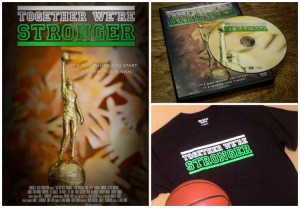A tale of two schools.
The Oscar statuettes have begun their stately walk to the Dolby Theatre in Hollywood, California. On the evening of February 28, 2016, the best of the big pictures will vie for the coveted trophies whose official name is the Academy Award of Merit but who has been known as Oscar since 1931.
A tale of two schools will not be there.
“Together We’re Stronger” is a documentary film centered on an inner-city building in Kansas City, Missouri. That structure has housed two schools and been home to decades of students. It is not a big place, and the film is not a big picture. The movie is a surprising story of heart, hard work and unexpected joys.
If he knew, I think Oscar would take notice and smile.
* * *
The story begins in 1961.
Three high schools in Kansas City, Missouri, are consolidating. Two will be all girls. The third will be coed and house all the boys.
On the first day of classes, the young men converge on Lillis High School. They are a different mix. Many probably don’t care much for the move or their new classmates. Before, they had been separate with their own ways and their own teams. Now, they’ve been forced together.
At the first practice, the basketball coach sees something special. In the eyes of those young men, he sees fight. In their moves, he recognizes skill. And in their sighs, he understands their need for identity. He gives them everything he has.
Their first basketball game, the opposing team scores 49 points. The Lillis men score more and win. No opponent will do better that season. The Lillis High School Basketball Team wins every game, and Lillis High goes on to win the 1961 Missouri State Basketball Championship.
* * *
In 2015, the remaining players sit on the bleachers of the old gym.
The coach and their top scorer have died suddenly weeks before. (Death swings fairly, if unkindly.) As they reminisce and the camera runs, sadness wrinkles the corners of their eyes and softens their smiles. They each have had their successes and they are grateful. The missing star won an Olympic gold medal and played professionally. One speaks of the remembered loss of a close relative and they reach together to comfort their teammate.
They are a team, and they will always be unlikely friends who became family at the old school.
* * *
Back to 1979, Lillis High is shutting down.
A group approaches. They need a larger space for their school and they’re willing to renovate. The DeLaSalle Education Center, an alternative charter school for students without a school, makes the old building its new home.
Like the 1961 Lillis team, the DeLaSalle students are a different mix. At first, many probably don’t care much for their surroundings or their new classmates. Like the Lillis coach, the DeLaSalle teachers see the fight in their students’ eyes, the skill in their moves and the need in their sighs. They give those young people all they have.
The students of Lillis became what they couldn’t in the old school. The students of DeLaSalle become what they can’t in the new school. The old building is alive again with friends becoming family.
In time, the students will move out and into the world. With persistence and perseverance, they too will find the unexpected joys their hearts desire. It is the legacy of the two schools.
* * *
One day, a Mom and Dad with their two children will stop outside an empty building in Kansas City, Missouri.
The boy, the great-great-grandson of a Lillis basketball player, will look up and ask, “What is it, Daddy?” The girl, the great-granddaughter of a successful DeLaSalle graduate, will point and ask, “What happened there, Mommy?”
With a smile lightening the corners of their eyes, the parents will answer together, “There were champions, children. There were champions.”
* * *
“Together We’re Stronger” is dedicated to the old and new schools and for the support of The DeLaSalle Education Center. Take a look and enjoy the show. www.twsmovie.com I think I see Oscar smiling.
Grandpa Jim

